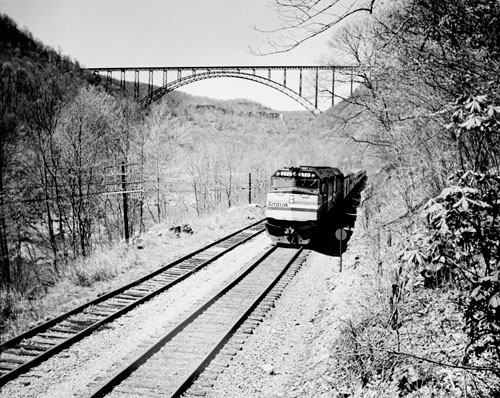The Cardinal and Its Rolling History Lesson
By Bob Withers

The Amtrak Cardinal carries passengers through the New River
Gorge three times a week. Photograph 1985 by David Fattalah, courtesy
of the West Virginia State Archives, Department of Commerce Collection.
Did you know that nylon was invented in Kanawha County? Or that Queen Victoria provided funds to establish the town of Caperton, Fayette County, so that coal could be mined there? Or that there once was a hospital at McKendree, a few miles up New River, where only woods, kudzu, and copperheads can be seen today?
You might, if you have ridden Amtrak’s eastbound Cardinal through the New River Gorge and have enjoyed narration offered by members of the Huntington based Collis P. Huntington Railroad Historical Society.
The Cardinal has been staffed for more than two decades by knowledgeable volunteers, such as current coordinator Jim Pickett of Kenova, Wayne County; retired trucker Bill Gillespie of Poca, Putnam County; and the Reverend Charles W. Aurand, a Wheeling native and 48 year Huntington resident. At present, 19 society volunteers are qualified to narrate aboard the thrice weekly Chicago New York passenger train.
The volunteers, who board the train at Huntington or Charleston, know their subject. And when they’re finished, the passengers do, too.
The New River Gorge, established as a National River in 1978, is rich with history. Narrators are equipped with a script, but many of them put a little extra jam on the bread. One of the finest in this regard is Rev. Aurand, retired pastor of Huntington’s St. Paul Lutheran Church, with whom we now tag along on a typical trip.
Well into his 80's, Aurand boards the Cardinal gingerly. He is clad in a brightly colored sport jacket. On one lapel is a flashing railroad crossbucks pin and a golden Lionel Train pin. His 25 year membership pin in the National Railway Historical Society on the other lapel. Another set of crossbucks adorn his tie, and his nametag is clipped to his jacket pocket.
He takes his station in one of the coach’s vestibules, where the public address microphone is located, and stands for more than three hours — all the way from Huntington to Hinton.
Aurand starts his narrative well before Charleston. He stuffs his script in his pocket and never refers to it once. Using his well honed pastoral eloquence, he talks extensively at times, without a single “ah” or “uh.”
“It’s a shame the state wasn’t named ‘Lincoln,’” he remarks half seriously as he explains West Virginia’s birth during the Civil War.
Narrators always tell about the state capitol, the first major landmark passengers see across the Kanawha River when the train departs Charleston. They point out the DuPont plant, also across the river in Belle, which originated nylon and many other modern chemical conveniences.
Aurand mentions a derrick in the Kanawha River. “They’re dredging coal lost from loading barges,” he notes.
Assistant conductor Howard Goodloe asks Aurand to make the Montgomery announcement for passengers disembarking there while the coach attendant assists a passenger. Under way again, the preacher resumes his monologue. “Now you’ll notice how wild the river is,” he points out near Deepwater.
When narrators mention the Elkem Metals plant at Alloy, Fayette County, passengers stare as the train passes the spectacular Kanawha Falls and the old bus that serves as a fishing camp on a rock out in the river at Gauley Bridge. “How did that bus get there?” their puzzled expressions seem to ask. [See “‘Bus On A Rock’: Bruiser Cole’s Camp at Gauley Bridge,” by Anna Sale; Winter 2005.]
Soon after the train starts up New River, passengers see its shallow “dries,” with house sized boulders strewn around in the streambed like so many children’s toys.
You can read the rest of this article in this issue of Goldenseal, available in bookstores, libraries or direct from Goldenseal.